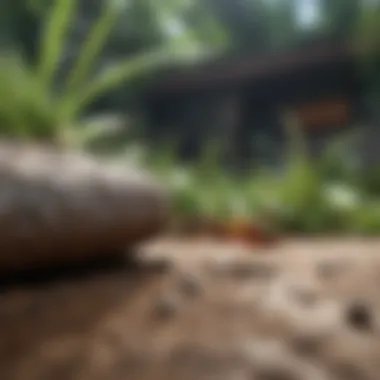Effective Strategies to Keep Ants Away from Home


Intro
Ants are often seen as a nuisance, but many people don't realize how their presence can disrupt daily life and even affect the health of your home and garden. With their determination and ability to form large colonies, they can create quite a quandary in just a matter of days. This article aims to guide homeowners and gardening enthusiasts through effective strategies that can help keep these tiny invaders at bay.
Understanding ant behavior is key to successful management. For instance, ants are social insects that communicate and work together effectively. They use pheromones to lead others to food sources, making it crucial to cut off their trail right at the source. Not only will this deter existing colonies, but it also prevents new ones from establishing.
This discussion will encapsulate a variety of methods such as natural remedies, chemical solutions, and preventive strategies tailored to fit different needs. By the end, readers will be well-equipped with knowledge to maintain a pest-free environment, enhancing the quality of not just living spaces but outdoor gardens as well.
Preamble to Ants and Their Habits
Understanding ants and their behaviors is crucial for anyone looking to keep their home pest-free. Ants are not just mere nuisances; they represent a complex social structure and possess habits that can lead to significant infestations if not managed well. By delving into their behavioral patterns, one can uncover the most effective strategies to deter them.
Understanding Ant Behavior
Ants are fascinating creatures. They are social insects that live in colonies ranging from a few dozen individuals to millions. Most people might be familiar with the idea that ants follow scent trails left by their companions. This is central to how they operate, as they rely on pheromones to communicate with each other about food sources and threats. It's this very behavior that can be exploited when trying to repel them.
Ants exhibit a strong need for gathering food and collaborating, which can be both a blessing and a curse for us homeowners. For example, while some species are harmless, others can damage structures or contaminate food. Recognizing their habit of seeking food can inform preventive measures, such as cleaning up spills quickly and sealing off food containers.
Common Ant Species in Homes
There are numerous ant species that may decide your home is the perfect foraging ground. This section focuses on a few of the most prevalent ones you'll encounter:
- Carpenter Ants: They bore into wood to create nests. They don't eat the wood but can cause significant structural damage over time.
- Odorous House Ants: Known for their distinctive smell when crushed, these ants tend to invade homes in search of sugary foods. Their presence points to a potential issue that could escalate without prompt attention.
- Sugar Ants: As their name suggests, sugar ants are attracted to sweet substances. They often enter homes through small crevices, creating foraging trails that can quickly lead to an infestation.
By understanding which species you are dealing with, you can tailor your approach to mitigation and prevention more effectively. Knowing their habits and characteristics is foundational in crafting a strategy that actually works.
Identifying Ant Entry Points
Understanding where ants infiltrate is crucial for any homeowner. Identifying these entry points allows you to take proactive measures before ants can turn your living space into their playground. Ignoring the signs of ant ingress can lead to an infestation, which can be a real headache to manage. By focusing on potential flaws in your home’s structure and being aware of external factors, you can effectively keep these pests at bay.
Recognizing Structural Vulnerabilities
When it comes to keeping ants out, the first step is inspecting your home for structural vulnerabilities. Ants may be small, but they are incredibly resourceful. They can squeeze through unbelievably little cracks and crevices. Here’s where you should look:
- Foundations: Check for cracks or openings, especially around the base of your house. A small gap may be an open invitation for ants to come crawling in.
- Windows and Doors: Ensure that screens are intact and that seals are tight. Gaps around window frames or doorways can serve as welcome mats for ants. Caulking can act like a fortress against their advance.
- Pipes and Electrical Wires: Pay attention to where pipes and wires enter your home. Use expanding foam or caulk to seal any little gaps.
Taking these preventive actions not only helps in keeping your space free from ants but also can aid in improving your home’s energy efficiency. It’s a win-win situation.
Common Outdoor Entryways
Outdoor spaces can be a major source of ant activity, and understanding where these ants typically enter is key to managing their populations. Here are some common outdoor entryways you might consider:
- Tree Branches and Shrubs: Ants can use tree branches that touch or lean against your house as bridges. Regularly trim them back to deny access.
- Mulch and Landscaping: Ants often thrive in mulch or densely packed soil beds. This not only provides them with cover but also nest-building material. Make sure to keep mulch away from the house foundation.
- Patio and Paver Stones: Unsealed gaps between patio stones can provide entry points. Ensure they are properly sealed and there are no new openings.
- Gutters and Drains: Clogged gutters can overflow, creating ideal pathways for ants. Regular cleanouts can prevent this.
"A stitch in time saves nine." Regular inspections and maintenance can significantly reduce ant presence around your home.
By keeping a watchful eye on these entryways, you empower yourself to act swiftly should any ant activity arise. The earlier you can identify potential access points, the easier it is to create a barrier against these persistent pests.
Natural Ant Deterrents


Natural deterrents are important tools in the fight against ants, serving as effective, eco-friendly alternatives to harsh chemicals. Homeowners are increasingly recognizing the value of such options, especially those who prefer to maintain a safe environment for their families and pets. By utilizing natural substances, one can not only deter ants but also contribute to overall pest management in a sustainable way. This section delves into several natural ant deterrents, emphasizing their advantages and considerations for practical use.
Vinegar and Water Solutions
A simple yet effective remedy for keeping ants at bay involves the use of vinegar and water. The mixture works on the premise that ants rely heavily on their sense of smell to navigate. Vinegar essentially masks their scent trails, making it difficult for them to find their way back to a food source. It’s as easy as mixing equal parts vinegar and water into a spray bottle and applying it to the areas where ants are most active.
Not only does this solution deter ants, but it also has the added benefit of cleaning surfaces without resorting to toxic cleaners. However, the strong smell of vinegar may linger temporarily, which some might find unpleasant.
Essential Oils as Natural Repellents
Peppermint Oil
Peppermint oil stands out as a popular choice among natural repellents. Its menthol scent is not only refreshing to humans but is quite repelling to ants. It can be mixed with water and applied around entry points. The key characteristic that makes peppermint oil particularly appealing is its dual function; it can freshen up a home while keeping ants at bay.
One unique feature of peppermint oil is that it can also deter other pests, which makes it multifunctional. However, it's important to note that the effects might need to be reapplied more often than synthetic pesticides, as the scent dissipates over time.
Lemon Oil
Lemon oil is another potent natural repellent. This oil is derived from the peels of lemons, providing a citrusy aroma that ants find unappealing. It's particularly effective in creating a barrier, as ants tend to avoid crossing paths with this scent.
The unique aspect of lemon oil is its versatility; it can be used in home cleaning solutions, leaving a fresh scent while offering protection from ants. One minor disadvantage is that, similar to peppermint oil, it may require frequent application for sustained effectiveness, especially in outdoor settings.
Cinnamon Oil
Cinnamon oil is revered not just for its delightful fragrance but also for its insect-repelling properties. The key characteristic of cinnamon oil is its ability to create a hostile environment for ants, disrupting their communication and navigation. When used around entry points or mixed with water and sprayed, it can form a line that ants are reluctant to cross.
Additionally, cinnamon oil has antifungal properties, which could benefit your home in more ways than one. However, like the others, its effectiveness may diminish over time, requiring repeated applications.
Diatomaceous Earth: A Natural Barrier
Diatomaceous earth is a powdery substance made from the fossilized remains of tiny, aquatic organisms known as diatoms. When sprinkled in areas frequented by ants, it acts as a physical barrier, damaging their exoskeletons and leading to dehydration. This option is particularly favorable as it poses minimal risk to humans and pets while being effective against a wide range of insects. It's learned that application may need to be redone after rain or watering in gardens.
Diatomaceous earth serves as a natural solution that not only controls ants but also helps manage other pests, making it a versatile choice in landscaping and home maintenance.
Chemical Solutions for Ant Control
In any battle against pesky ants, especially in residential settings, employing understanding of chemical solutions offers a pivotal advantage. While natural deterrents may sometimes suffice, the relentless nature of certain ant species can necessitate a more assertive approach. Chemical solutions encompass a range of products designed to target various life stages of ants, ultimately disrupting their colonies and maintaining a pest-free environmnet.
Using chemical solutions has distinct benefits. Primarily, they often yield faster results, especially in a larger infestation. For homeowners dealing with an overwhelming number of ants, this immediacy can feel like a breath of fresh air. Moreover, many formulations are designed not just to eliminate ants, but to deter future invasions, allowing one to regain peace of mind. However, it is important to consider the implications of chemical usage. Careful attention should be paid to safety, particularly in homes with pets or children.
Ant Baits and Their Efficacy
Ant baits are a popular method within the category of chemical solutions. They operate on a simple albeit effective premise. The bait contains a slow-acting poison mixed with attractive food, enticing ants to take it back to their colonies. This mechanism targets the queen and other ants, leading to systemic eradication over time.
The efficacy of ant baits largely depends on the species involved and the location of the application. For instance, some baits work better for problematics like Carpenter Ants or Argentine Ants than others. Additionally, it's paramount to place these baits strategically. Common spots include near entry points, along ant trails, and close to nests if identified. Patience is key, as results may not be instantaneous.
"Utilizing ant baits requires a thoughtful approach; successful implementation can prevent the return of these nuisances for seasons to come."
Sprays and Granules in Pest Management


While baits tackle the root of the problem, sprays and granules serve a different purpose within the toolkit of chemical solutions. Sprays are typically used for immediate action, offering a quick kill for ants that are visible. These formulations often contain powerful insecticides that can neutralize ants on contact, helping to provide immediate relief from a troubling invasion.
On the other hand, granules are designed for longer-lasting control. When spread around the perimeter of the home or within the garden, they create a barrier that ants must cross, delivering a lethal dose. Sprays and granules often have specific application guidelines. It's key to follow these closely to ensure the right amount reaches the ants while minimizing exposure to non-target organisms like beneficial insects or pets.
In summary, understanding the nuances of chemical solutions, including ant baits and sprays, is essential for effective ant control. These methods, when employed with precision and care, provide an arsenal for homeowners determined to reclaim their spaces from the relentless advance of ants.
Preventive Measures Against Ant Infestations
Keeping ants at bay requires more than just reactive solutions; it calls for comprehensive preventive measures. This is the first line of defense against these unwanted pests. When you proactively manage your space, the likelihood of an ant infestation diminishes significantly. Let's break this down more clearly.
Maintaining a Clean Environment
Ants are notoriously opportunistic feeders. They love gallivanting around for any morsel they can sniff out. If your home isn’t spotless, you might as well be rolling out the red carpet for these little invaders. Regular cleaning is essential. Daily tasks like sweeping up crumbs and wiping down surfaces not only keep your kitchen tidy but also strip ants of their food sources.
Consider these steps for a cleaner space:
- Sweep and vacuum regularly, especially in areas where you cook and eat.
- Wash dishes promptly after meals to avoid leaving food residue.
- Take the trash out frequently and ensure bins have tight-fitting lids.
Remember, even the tiniest crumb can attract a swarm of ants.
Proper Food Storage Techniques
Once you ace the cleaning routine, the next move is all about how you store food. Ants are crafty; they can sense food from afar. Use airtight containers for storing leftovers, grains, and snacks. This simple act eliminates the scent that beckons ants. Here’s a few pointers:
- Utilize glass or plastic containers with airtight seals.
- Keep pet food stored securely, too—never leave it out overnight.
- Label pantry items and rotate your food stock to minimize waste and spoilage.
By minimizing food accessibility, you increase your chances of keeping ants at bay.
Sealing Entry Points and Gaps
Even if you’ve cleaned your home and stored food like a pro, you could still be at the mercy of ants if they find shaded paths inside. Sealing entry points creates a fortress against these unwelcome guests. Inspect your home thoroughly for cracks, crevices, or any openings. Here’s what to do:
- Use caulk or sealant to close gaps around windows and doors.
- Inspect and repair any damaged screens.
- Don’t forget the foundation—look for fissures and seal those up.
“An ounce of prevention is worth a pound of cure.” This old adage rings true when it comes to guarding your home against ants.
Being diligent in these three aspects of preventive measures can drastically reduce your chances of an ant invasion. Homeowners who invest the time in these practices are likely to see a noticeable difference in their living environment.
Landscaping Strategies to Deter Ants
Landscaping serves not only as a decorative element around homes but also plays a vital role in combatting pesky intruders like ants. This section will dive into how thoughtful landscaping choices can make your property less inviting to these little invaders. By understanding the nuances of ant behavior alongside your gardening practices, you can significantly limit their presence.
Selecting Ant-Resistant Plants
Choosing the right plants for your garden can be a game changer when it comes to ant infestations. Certain species inherently repel ants through their scent or chemical composition, creating a natural barrier against these unwanted guests. Some notable ant-resistant plants include:
- Lavender: This fragrant herb not only adds beauty to your garden, but its strong scent is known to deter ants. It thrives in well-drained soil and needs full sunlight.
- Mint: With its sharp aroma, mint can be a formidable opponent to ants. It's also quite hardy, making it a good choice even for less seasoned gardeners.
- Rosemary: Another aromatic herb, rosemary grows well in a variety of conditions. Its resinous nature tends to keep ants at bay.
Consider mixing these plants throughout your garden beds and borders. Not only does this create an aesthetic appeal, but it keeps ants guessing as to where their next meal might be.


Creating Barriers with Mulching
When it comes to landscaping strategies, mulching can act as a formidable barricade to ants. By laying down a good layer of mulch, you can achieve multiple benefits:
- Moisture retention that helps plants thrive, ultimately reducing the necessity for watering.
- Temperature control for the soil beneath, making it more hospitable for plants but less so for ants, who generally prefer warmer, dry conditions.
- A physical barrier that makes it challenging for ants to traverse your yard.
When selecting mulch, consider using cedar or pine bark, as they can emit scents that deter both ants and other pests. Additionally, an appropriate depth (around three to four inches) ensures that it functions effectively. Not only will your garden enjoy the benefits, but with the right approach, you’ll also send ants packing.
"Adapt your gardening approach not just to beautify your home, but to also create an environment where ants and other pests think twice before settling down."
Incorporating these landscaping strategies into your routine can be an effective way to mitigate ant problems before they begin. With a little planning and the right choices, your outdoor space can be both inviting for people and less so for ants.
Monitoring and Long-Term Strategies
Monitoring and employing long-term strategies is critical in keeping ants at bay. While immediate solutions can provide quick relief from an ant intrusion, it is the consistent observance and modification of tactics that ensure lasting results. Ants often behave like little soldiers, returning to the same spots, so understanding their patterns is necessary for a robust defense. Homeowners must remain vigilant in identifying ongoing activity and adapting their methods to the evolving behavior of these pests. Here we will delve into two key aspects: regular inspections and adjusting strategies based on what you observe.
Regular Inspections of Affected Areas
Conducting regular inspections of areas that ants frequently invade is an essential strategy that should not be overlooked. It’s akin to a routine health checkup for your home. By systematically examining places like kitchens, bathrooms, and entry points, you can detect ant activity before it escalates into a full-blown infestation. Look for signs such as small trails, discarded body parts, or even the ants themselves scurrying about.
Considerations for Regular Inspections:
- Check pantry items and food containers for signs of ants.
- Inspect outdoor areas close to your home, like the foundation and garden beds, for potential nesting sites.
- Observe the seasons; ant activity can fluctuate with the change in weather. More ants tend to appear when the temperature rises, so stay alert during warmer months.
By making inspections part of your routine, you foster an environment where ants feel unwelcome. Recording your findings can help track the effectiveness of your strategies and highlight any necessary adjustments.
Adjusting Strategies Based on Ant Activity
Once you’ve conducted your inspections, the next step is to adjust your strategies based on the patterns you observe. For instance, if you know that the ants tend to invade shortly after a rainfall, you might want to reinforce barriers before the forecasted rain. Alternatively, if you notice they predominantly enter through specific locations, consider intensifying deterrent measures in those targeted spots.
Effective Adjustments Might Include:
- Rotating natural repellents—if peppermint oil doesn’t seem to work this time, try lemon oil or cinnamon oil instead.
- Fortifying physical barriers, like sealing cracks and holes that allow for easy access.
- Changing your food storage practices; consider investing in airtight containers or regularly disposing of old food items in the pantry.
Here’s a crucial point to consider: ants are incredibly adaptive. They can quickly learn to bypass barriers or ignore certain deterrents. That’s why continuous evaluation and modification of your methods are vital.
"A proactive approach is often the best protection against the ant army. You can silence their march before it grows loud."
Epilogue and Final Thoughts
Understanding how to keep ants at bay is not just a matter of personal comfort; it also plays a critical role in maintaining a healthy home environment. Ants are tiny yet tenacious creatures that, once they establish themselves in a space, can rapidly become a nuisance. The knowledge presented in this article helps empower homeowners and gardening enthusiasts, offering practical insights and effective strategies to manage ant populations before they can settle in.
Summary of Effective Ant Control Techniques
When we consider pest control, the options can seem daunting. Through this article, we've highlighted several effective ant control techniques:
- Natural deterrents like vinegar mixtures and essential oils that can keep ants at bay without resorting to harsh chemicals.
- Chemical solutions, which, while necessary in some cases, should be applied judiciously to avoid impacting beneficial insects.
- Preventive measures, such as ensuring proper food storage and regular cleaning habits, to make homes less attractive to ants.
- Landscaping strategies, including the selection of ant-resistant plants, to influence the surrounding environment positively.
- Regular monitoring, which is crucial for adapting strategies as ant activity fluctuates throughout the seasons.
By utilizing a combination of these techniques, homeowners can create a comprehensive ant management plan tailored to their specific situations.
"The best way to deal with ants is not to let them in the first place. Prevention is your first line of defense."
Encouraging Sustainable Practices
Embracing eco-friendly practices not only supports the environment but can also lead to more effective and long-term ant control. For example, when using natural repellents like essential oils, homeowners can minimize their chemical footprint, contributing to a healthier habitat for both humans and other organisms. Choosing ant-resistant plants in gardens not only supports insect diversity but decreases the likelihood of ant invasions.
Some sustainable practices to consider include:
- Composting: This method not only helps divert waste but can also attract beneficial organisms that naturally control ant populations.
- Organic gardening: Utilizing organic methods to nurture plants makes it more challenging for ants to find food sources, ensuring they stay away.
- Waste management: Properly managing waste by securing trash bins and compost piles helps deter ants from scavenging opportunities.
By implementing these sustainable strategies, we not only tackle the immediate issue of ant invasions but also foster a more balanced environment in the long run. The journey toward a pest-free home can indeed be enriched with practices that are kind to our surroundings.



